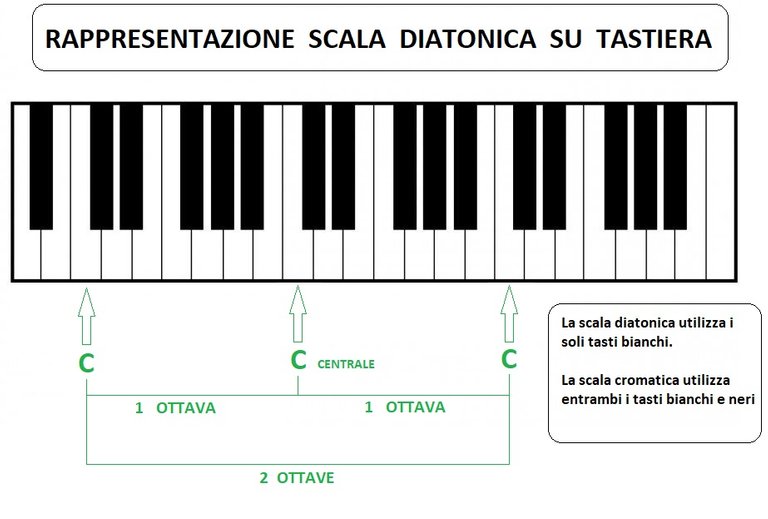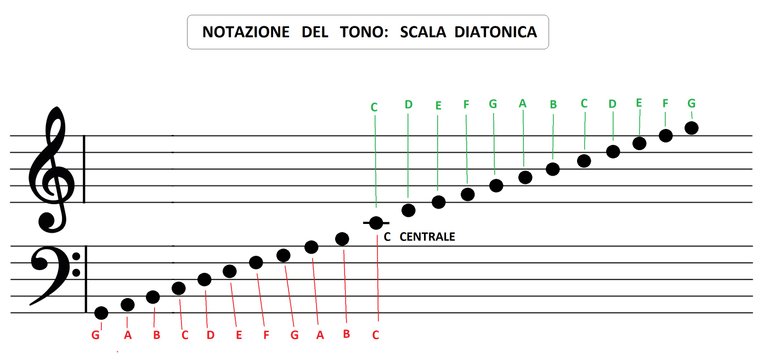Tone and semitone.
Hello Steemians, welcome back with our musical appointment. Today we are talking about the "distance" between two notes, namely the tone and the semitone.
It is self-evident that a tone is formed by two semitones, being the prefixid "seeds" synonymous with half.
To represent tones and semitones of the notes, the seven denominations that derive from an ancient acrostic are used: Do-Re-Mi-Fa-Sol-La-Si.
They are the seven natural notes.
This name is universally recognized except (and it seemed to you!) That in the Anglo-Saxon countries and in Germany where a nomenclature is used which refers to the alphabet: C-D-E-F-G-A-B (in place of B in German the H is sometimes found).
Warning! The notes are always the same as we know, it's only the terminology that is different! In modern music the use of the Anglo-Saxon notation has become increasingly widespread, so we will always refer to that.
The system of the seven note names is repeated cyclically with each octave. That is, the eighth note starts again from the first but with a higher sound if the octave is higher, lower if the octave is lower. It is a physical phenomenon based on the proportion of 2: 1 between the frequencies of the two notes . It is called "register".
The piano keyboard is the most immediate visual expression of this system. The natural notes we have previously discussed, are found on the white keys and starting from the C key, playing the seven notes, on the eighth fret we will have a G but again of the higher octave. This succession of notes is called "diatonic scale".

In the space of this octave played on the white keys, we have noticed, however, that there are also smaller black keys, five to be exact in the space of an octave, and how can we identify them? These black keys are nothing but altered notes and will take the name of the nearest reference note, in sharps if we go up, in flats if we go down. So for example the Re # will have the same sound as the Mi b, but based on the tonality we are in, it's not quite the same thing, we would make a musical spelling mistake.
But we will come back to this topic later. There are, however, two notes that do not have alterations in both directions and are the Fa and the Si: The Fa does not have the alteration in flats since it is only one semitone from the Mi, while the Si has no alteration in sharps since it is a semitone from the Do.

So to sum up, the distance of the notes of a diatonic scale is the following: 2T - 1st - 3T - 1st, where the T stands for tone and st semitone.
Using this ladder, starting from a certain note, we will find the right notes to play on the tonic.
The tonic is the starting note.
Playing all the notes including the altered in the reference octave, we will have played a "chromatic scale"
This described above is the system that is the basis of Western music.
In the next articles we will also discuss this topic, don't worry!
Thank you for your time, a big hello to everyone! Bye!
I toni ed i semitoni.
Buongiorno amici Steemians e ben ritrovati col nostro appuntamento musicale. Parliamo oggi della "distanza" tra due note, ovvero il tono ed il semitono.
E' lapalissiano che un tono è formato da due semitoni,essendo il prefissoide "semi" sinonimo di metà.
Per rappresentare toni e semitoni delle note, si usano le sette denominazioni che derivano da un antico acrostico: Do-Re-Mi-Fa-Sol-La-Si.
Esse sono le sette note naturali.
Tale denominazione è riconosciuta universalmente tranne ( e ti pareva!) che nei Paesi anglosassoni ed in Germania dove viene utilizzata una nomenclatura che si rifà all'alfabeto: C-D-E-F-G-A-B (al posto di B in tedesco a volte si trova la H).
Attenzione! Le note sono sempre le stesse che conosciamo, è solo la terminologia che è differente! Nella musica moderna ha preso sempre più piede l'uso della notazione anglosassone, perciò faremo riferimento sempre a quella.
Il sistema dei sette nomi delle note si ripete ciclicamente ad ogni ottava. Ovvero, l'ottava nota ricomincia dalla prima ma con un suono più alto se l'ottava è superiore, più basso se l'ottava è inferiore.Si tratta di un fenomeno fisico basato sulla proporzione di 2:1 tra le frequenze delle due note. Viene chiamato "registro".
La tastiera del pianoforte è l'espressione visiva più immediata di questo sistema. Le note naturali di cui abbiamo precedentemente trattato, si trovano sui tasti bianchi e partendo dal tasto del Do, suonando le sette note, all'ottavo tasto avremo di nuovo un Do ma dell'ottava superiore. Questa successione di note si chiama "scala diatonica".

Nello spazio di questa ottava suonata sui tasti bianchi, abbiamo notato però che esistono anche dei tasti più piccoli neri, cinque per l'esattezza nello spazio di un'ottava, e come li possiamo identificare? Questi tasti neri, non sono altro che le note alterate e prenderanno il nome della nota di riferimento più vicina, in diesis se saliamo, in bemolle se scendiamo. Quindi ad esempio il Re # avrà lo stesso suono del Mi b , ma in base alla tonalità in cui siamo, non è proprio la stessa cosa, si commetterebbe un errore di ortografia musicale.
Ma su questo argomento ci torneremo più avanti. Ci sono però due note che non hanno le alterazioni in entrambe le direzioni e sono il Fa ed il Si: Il Fa non ha l'alterazione in bemolle dato che dista un solo semitono dal Mi, mentre il Si non ha l'alterazione in diesis dato che dista un semitono dal Do.

Quindi riassumendo, la distanza delle note di una scala diatonica è la seguente: 2T - 1st - 3T - 1st , dove la T sta per tono e st semitono.
Utilizzando questa scaletta, partendo da una determinata nota, troveremo le note giuste da suonare sulla tonica.
La tonica è la nota di partenza.
Suonando tutte le note comprese le alterate nell'ottava di riferimento, avremo suonato una "scala cromatica"
Questo sopra descritto, è il sistema che sta alla base della musica occidentale.
Nei prossimi articoli tratteremo anche questo argomento, non preoccupatevi!
Grazie per il vostro tempo, un grande saluto a tutti! ciao, alla prossima!
Pics from author.
Congratulations @hjmarseille! You have completed the following achievement on the Steem blockchain and have been rewarded with new badge(s) :
You can view your badges on your Steem Board and compare to others on the Steem Ranking
If you no longer want to receive notifications, reply to this comment with the word
STOPTo support your work, I also upvoted your post!
Questo post è stato condiviso e votato all'interno del discord del team curatori di discovery-it.
This post was shared and voted inside the discord by the curators team of discovery-it
che belle queste lezioni di musica....sarebbe interessante anche riuscire nel suono dello strumento
Grazie, mi sto organizzando per quello....